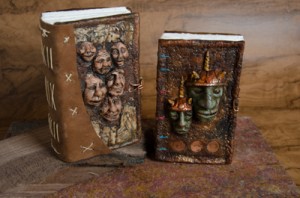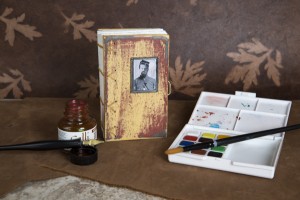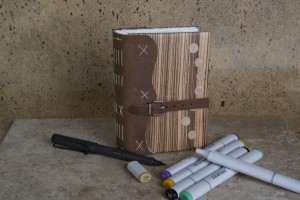by Steve | Jul 28, 2014 | Bookbinding, Polymer Clay, Workshops |
Art Unraveled kicks off in Phoenix tonight with a meet the artist event. If you haven’t attended, Art Unraveled is a week long art event that features classes taught by internationally known artists. There are over 125 workshops that cover a broad range of media like painting, book making, jewelry making, metal work, journaling, fiber/fabric arts, sculpting and assemblage.
I’ll be teaching three classes at Art Unraveled this year, Dug from the Ruins, a journal created from polymer clay; Work by Time, a coptic bound art journal with wood covers and the Inlaid Wood journal wood covers with small circular inlay.
If you’re attending Art Unraveled this year, stop by and say hello.

Dug from the Ruins

Worn by Time

The Inlaid Book
by Steve | Jul 18, 2013 | Polymer Clay, Recently Bound |
Generally, when I make a book from polymer clay, I use translucent clay or Super Sculpy. Once the journal is done, it’s painted with acrylic paint and over the life of the journal the paint wears away on the high spots revealing the clay underneath. On most journals, the result is a nice worn look, it almost creates a patina. Lately though, I’ve been experimenting with using colored clay to create sculptural journals and here’s a couple of shots at my first attempt The Octopus Journal it was created using Red Pearl clay over a base of Pearl clay. As I worked with the clay and the layer of Red Pearl became thinner and thinner, the sculpture began to take on a luminescent quality. Comments are welcome.


by Steve | May 7, 2013 | Polymer Clay, Recently Bound |
I recently finished a new pocket journal inspired by the science fiction classic The Fifth Element. The journal is constructed from polymer clay, the front of the journal features a sculpture of a Mangalore and the four stones. The back of the journal features an image transfer of a Mondoshawan created with liquid polymer clay. The book block is constructed from 300 gm Fabriano Artistico bound with a coptic stitch.



by Steve | Jan 5, 2013 | Polymer Clay, Recently Bound |
I was searching for a texture plate the other day and while I was rifling around in one of the drawers that I keep molds in, I stumbled across one of those silicone ice molds. Someone gave it to me at a birthday party as a gift, I think was the sentiment was something like “Ha! you’re getting older now, here’s a mold to make ice dentures”. I threw it in a pile with all the other silly cliche presents and apparently it got tossed in with all the other molds.
I pulled the mold out of the drawer and decided to make something out of it. I molded up a few sets of heath using some Pearl Premo and Super Sculpey. They sat around uncured for a few days while I though about exactly what to make out of them and for some reason, what emerged was The Book of Tasty Peas.
Here’s a shot of the from cover.



by Steve | Dec 26, 2012 | Polymer Clay |
If you’ve read this blog, you know I work in a variety of mediums; wood, metal, paper and polymer clay to name a few. Recently, I’ve been fooling around with the Mokume-gane technique again. It’s a great technique and you can achieve amazing results with it but one area in which it falls short, at least for me is in creating large flat sheets like book covers. At any rate, I was tinkering with it when a friend stopped by to drop off some holiday cookies and I had the block and some shavings out on my work surface. If you haven’t tried this before, basically you layer up a block of different colors, deform the layers to provide interesting patterns and then shave thin slices off the surface of the block. This particular friend is a little OCD and is particularly fond of orderly stacks of things and when they saw the thin shavings I’d taken off the block and other partial blocks of clay scattered around asked, “what happens to all the scraps?”

Most people who work with polymer clay have scrap bins and every bit eventually gets used. Sometimes similar colors just get mixed together for a project or it may all just get mixed into some muddy grey or brown chunk of clay that ends up as a base or unseen part of a project. This time, I just decided to use the scraps on the spot and see if I could preserve the variance in the colors I had used in the mokume-gane block. I think an email from one of the big box craft stores triggered this; frankly I didn’t read the thing but I swear it had something about Valentine’s Day in the subject. A few minutes later, I had shaped the scraps into a pile of hearts. In the photo below, you can see a few of them, the three on the left are raw clay and the three on the right are already baked. The only difference you may notice is that the colors are a little deeper in the ones that have been baked.

Once baked, I wet sanded then starting at 400 grit and ending at 1200 grit. Your average craft store or Home Depot type sandpaper isn’t meant to be used for wet sanding so pay a visit to your local auto paint store, they’ll have the stuff in stock ranging from 400 grit to 2000 grit. Once the wet sanding was complete, I took the outside to my buffing wheel and buffed them out to a high gloss. Here are a couple of shots of the finished ones. I should probably mention at this point that Sculpey may not work for this; you can do the mokume-gane technique using Sculpey, but it won’t buff to a high glass like Premo or Fimo will.


I’m pretty happy with the way the colors play together and the big surprise was they way the plain old Super Sculpey worked out. That’s pretty much it. The only thing left to do is drill into the top of each heart and add a sterling eye pin so it can be strung as a necklace or earring. Cheers.
by Steve | Mar 24, 2011 | Polymer Clay, Recently Bound |
Not too long ago I heard a story on NPR about the ways in which science fiction has predictive of the future. One of the movies they talked about in the story was Forbidden Planet, a movie I hadn’t actually seen its entirety until recently. The story was the only excuse I needed to watch the movie again, it was also a way to honor Leslie Nielsen who died back in November.
A couple of days after the movie an idea for a new book started to form and after tinkering a bit with some polymer clay, The Book of Altaria was born. The book block consists of eight, three page signatures which are sewn to a leather spine with 4-ply waxed Irish linen. The image in the “view screen” is a picture of Anne Francis who played Altaria i the movie.


The book really isn’t a direct interpretation of anything that was in the movie but just another lamentation on decay and post apocalyptic artifacts.

















